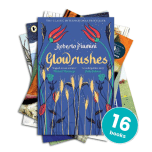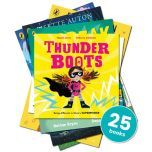Uncover the secrets of a high-quality text
After laying the foundations of reading with phonics, nothing captures the attention of a newly independent reader more than the lure of a great book. Making sure the very best books make it into your pupils’ hands will not only benefit them, it will also make your job of inspiring young readers and boosting progress in reading much easier.
Making informed choices about the books you use in English lessons and fill your library shelves with will also help you to answer questions that might come up in your next Ofsted deep dive. Whilst the DfE Reading Framework emphasises the importance of ensuring children are given high-quality texts, there is little guidance on what a high-quality text looks like or how the calibre of a text can be recognised and measured. Being able to identify quality literature will ensure children are exposed to the very best, most current fiction, including titles that reflect modern society and represent more diverse authors, rather than relying on a stagnant diet of go-to favourites.
We aim to unveil the secret to finding the very best books, by revealing the top 5 indicators of a high-quality text. These attributes can be applied to any book, from a picture book used in Reception to a lengthy year 6 novel. Read on to find out more…
A high-quality text will:
1 …have a strong narrative that sustains multiple readings.
Reading a book multiple times not only increases familiarity with the story and fosters greater emotional engagement, it also sets up opportunities for a much deeper understanding of the language, characters and story structure. Along with increased comprehension and retention comes the child’s ability to retell or reread the story for themselves. The comfort and thrill of knowing what’s coming next, looking forward to their favourite bit or being able to join in, will strengthen their attachment to the story and nurture a life-long love of books and reading.
The following collections have been put together for just this purpose. These all-time classroom favourites and modern day must-reads will captivate readers and are perfect to be read over and over again!
Books to Read Before You Are 9…
Books to Read Before You Are 11…
2…provide many opportunities for discussion and writing.
A high-quality text will lend itself to close scrutiny, stimulate discussion and provide opportunities for ‘wonders’ and questions to be asked. A text that is open to interpretation, leads to conversations about wider historical or social themes or holds thought-provoking illustrations that support, extend or provide insight, will contain this important secret ingredient.
3…have been written by a wordsmith.
A skilled author will stimulate, engage and educate the reader. Their well-crafted words might incorporate figurative language to ignite imaginations, convey a message, build imagery, deepen understanding or evoke an emotional response. Ask yourself if the text you are presenting to your pupils will broaden their experience of language, provide a stimulating reading challenge and be a superb model for their own writing. Picture books should play with rhyme, rhythm and other language patterns skilfully, to make reading both enjoyable and meaningful.
4…help children connect with who they are and reflect upon the lives of children from cultures and backgrounds different to their own.
High-quality texts will support all children to thrive by acting as mirrors where they see themselves reflected as the main protagonist and by opening new windows into the worlds of those whose experiences and perspectives are different from their own. Quality texts will offer diverse characters to talk about, support writing from different perspectives, reflect the real world and both represent and widen the horizons of the children reading them. From Michelle Magorian’s Goodnight Mr Tom to Onjali Q. Raúf’s Boy at the Back of the Class, it is the encountering of difference that is at the heart of great writing. Examples of this might include exploring differences in gender, age, culture, ethnicity, sexuality, place, religion, social or economic group; or experiencing the world from the point of view of a character with a disability or of a young carer. Look out for texts written from a personal experience, which will ensure an authentic representation.
Our book experts at Badger Learning have curated some exceptional examples of diverse and inclusive fiction for primary school pupils in the collections below:
Celebrating Diversity & Inclusion for KS1
Celebrating Diversity & Inclusion for KS2
Celebrating Diversity & Inclusion for Primary
5…be a shining example of it’s genre.
Always be on the look-out for books that would sit well alongside the greats and that are pronounced in their own right, rather than being copycat versions. Maybe you will find a picture book with a wonderfully memorable rhythmic text that reminds you of We’re Going on a Bear Hunt. Any high-quality text will stand out by excelling in one or more attributes of its genre and any illustrations will reflect this quality by expertly supporting or extending the text. Whether it’s an immersive adventure, a perfectly evoked period in time, or a storyline that casts a new light on a familiar one, there is no mistaking a book that shines and stands out from the rest when you find it.
View our collections of Hottest New Titles, which celebrate high-quality, most recently published texts for pupils from reception to year 6 all of which meet the criteria for high-quality texts, ideal for sharing with the whole class.
Hottest New Titles for Summer 2023
Hottest New Titles for Spring 2023
Our team of book specialists at Badger Learning are continually reading countless books to cherry pick only the very best for these collections. If this isn’t something you have time to do let us do the hard work for you and look out for next term’s recommendations!
Questions to ask yourself before deciding on a text.
Do you love this story?
Whilst every book you love isn’t automatically guaranteed greatness, your enthusiasm, (or lack of it,) is highly likely to be picked up on by your pupils and replicated. Promoting a love of books and reading through your own obvious enjoyment, active participation and value given to a text can be a powerful catalyst for encouraging reading for pleasure across your class. Find books that light a fire inside you that can be used to ignite a passion for reading in your pupils!
Is this book going to excite and engage the children in your class?
Sourcing books which children find emotionally engaging can catalyse a reading life. These texts evoke a response or reaction which will lead to increased motivation, curiosity, discovery and improved wellbeing. The affirming cycle of finding ‘good fit’ texts leads to a positive association with books, increased enjoyment and greater interaction with books and reading. Conversely, texts which do not excite or engage your pupils will have the opposite effect and can lead to frustration, boredom or reading avoidance. Talking to your pupils and asking questions about their reading habits and interests will help you find books that will motivate and inspire them. This, together with your knowledge of their reading ability, makes you best placed to guide children’s choices and present them with books that are just right for them.
A few words on emotional engagement may also be helpful here. Positive attachment to a story feeds engagement and enjoyment but it is important not to shy away from books featuring more challenging experiences which can help children to make emotional connections with characters and situations, or which promote empathy and understanding. Themes of loss and separation are an important feature of children’s literature but bear in mind that if a book becomes distressing for your class you could be undermining reading for pleasure. Only you can make this choice for your class, and it is equally valid to include or exclude wonderful books based on your knowledge of the children in your care. Aim for an emotional impact but not anguish. Of course, not selecting a book as a class text does not mean that individual readers cannot enjoy reading it.
Browse the following book collections for books which will help foster emotional engagement in a supportive way:
Does this book bring something new?
No single book can provide your class with the full reading diet they need, and the English curriculum requires but a collection of well-chosen high-quality books will. Therefore, it’s important to consider all your book choices for the whole year to ensure you have a good range of texts with a variety of genres, settings, characters, authors and themes to keep pupils engaged and broaden their experience of high-quality literature. Being exposed to a wide range of text types, voices and styles will help pupils develop reading skills, become confident in forming opinions, preferences and book choices and bring understanding of writing for different purposes and audiences to their own written compositions. Having an overarching knowledge and understanding of the books your pupils are reading will ensure a hearty diet of literature and make sure that no ingredient to reading enjoyment and success is left out.
Why choose a book-led curriculum?
The benefits of reading are inexhaustible. Through reading, children acquire essential skills and knowledge in order to thrive and achieve best possible outcomes across the board. It is easy, therefore, to see why many schools are deciding to put books and reading at the heart of the curriculum. Making sure these books placed as the driving engine of all learning are of the highest quality is more important than ever. If a book does not enthuse you or your pupils, is not pitched at the right level to successfully support their ability or lacks the new vocabulary and language patterns to provide progress and challenge, then it should have no place in your collection. Look for books that inspire creative thinking, generate questions, and promote learning opportunities, these are your high-quality texts.
A vibrant high-quality book-led curriculum can be the driving force for connecting the book with the child, creating readers for life and transforming outcomes.
Helpful links:
More about choosing high-quality texts:
How to use quality texts in the classroom for better student outcomes: Dr Lorraine Beveridge (PETTA)
Choosing and Using Quality Texts by Louise Johns-Shepherd (CLPE)
To find out more about the types of questions asked in an Ofsted deep dive inspection:







